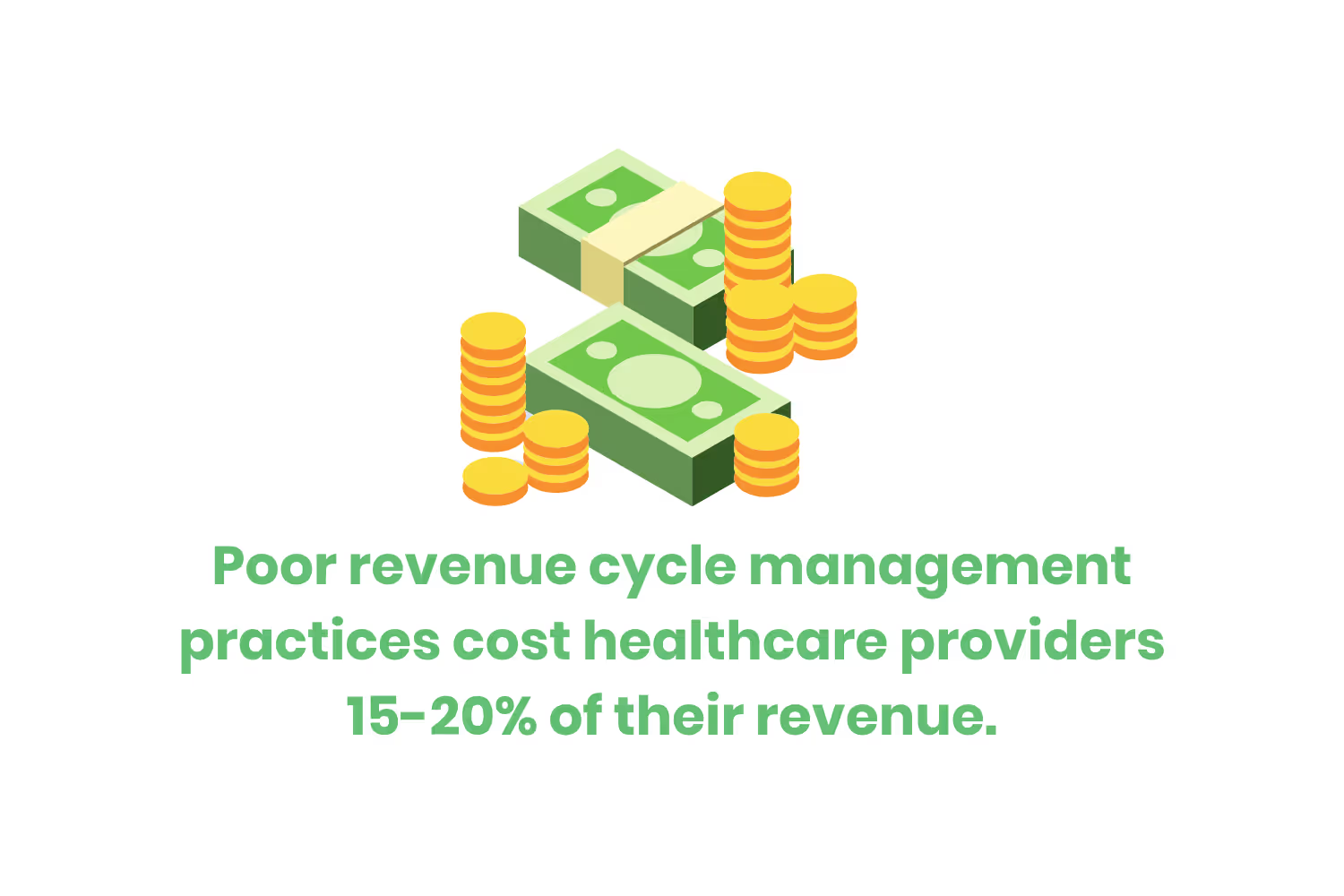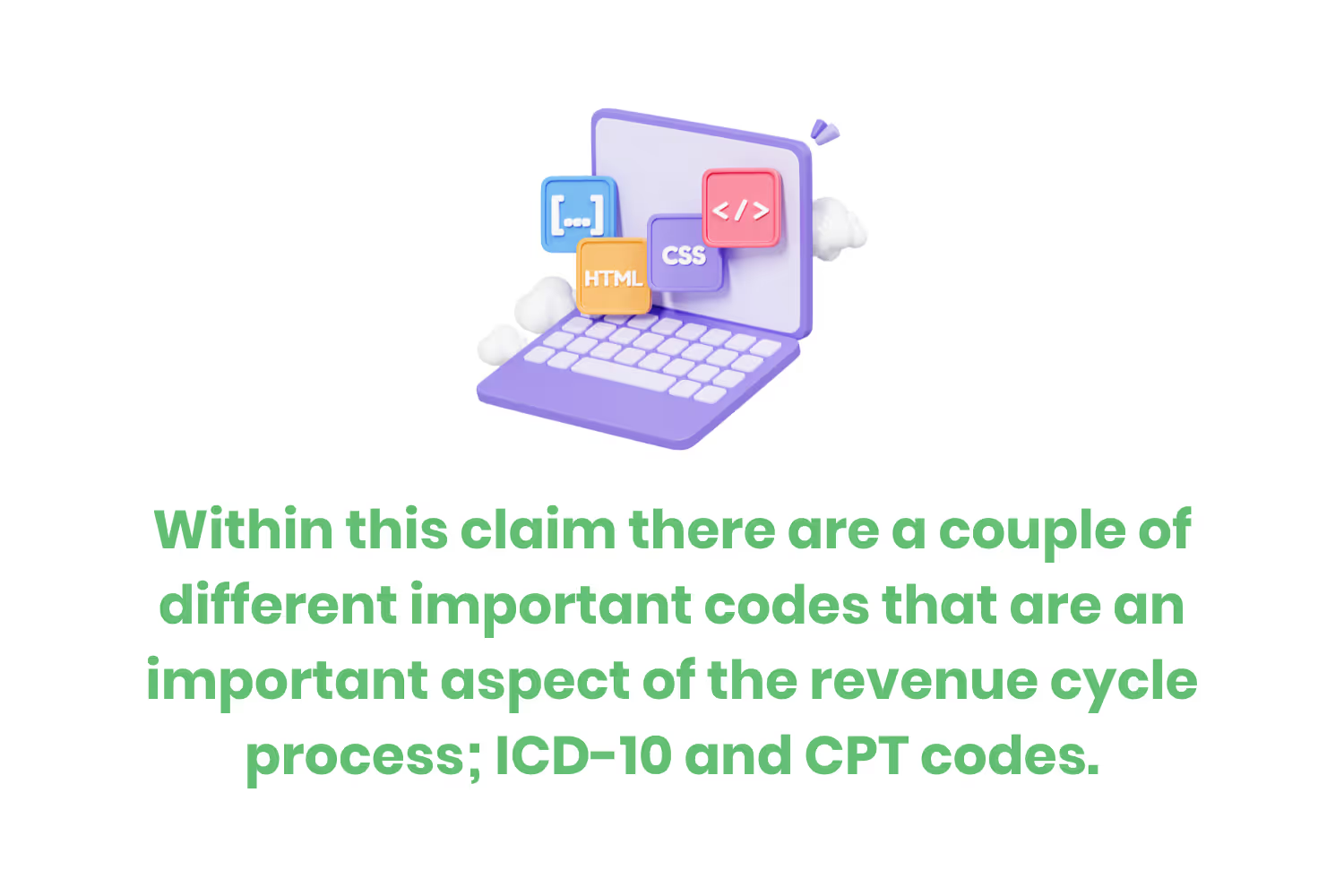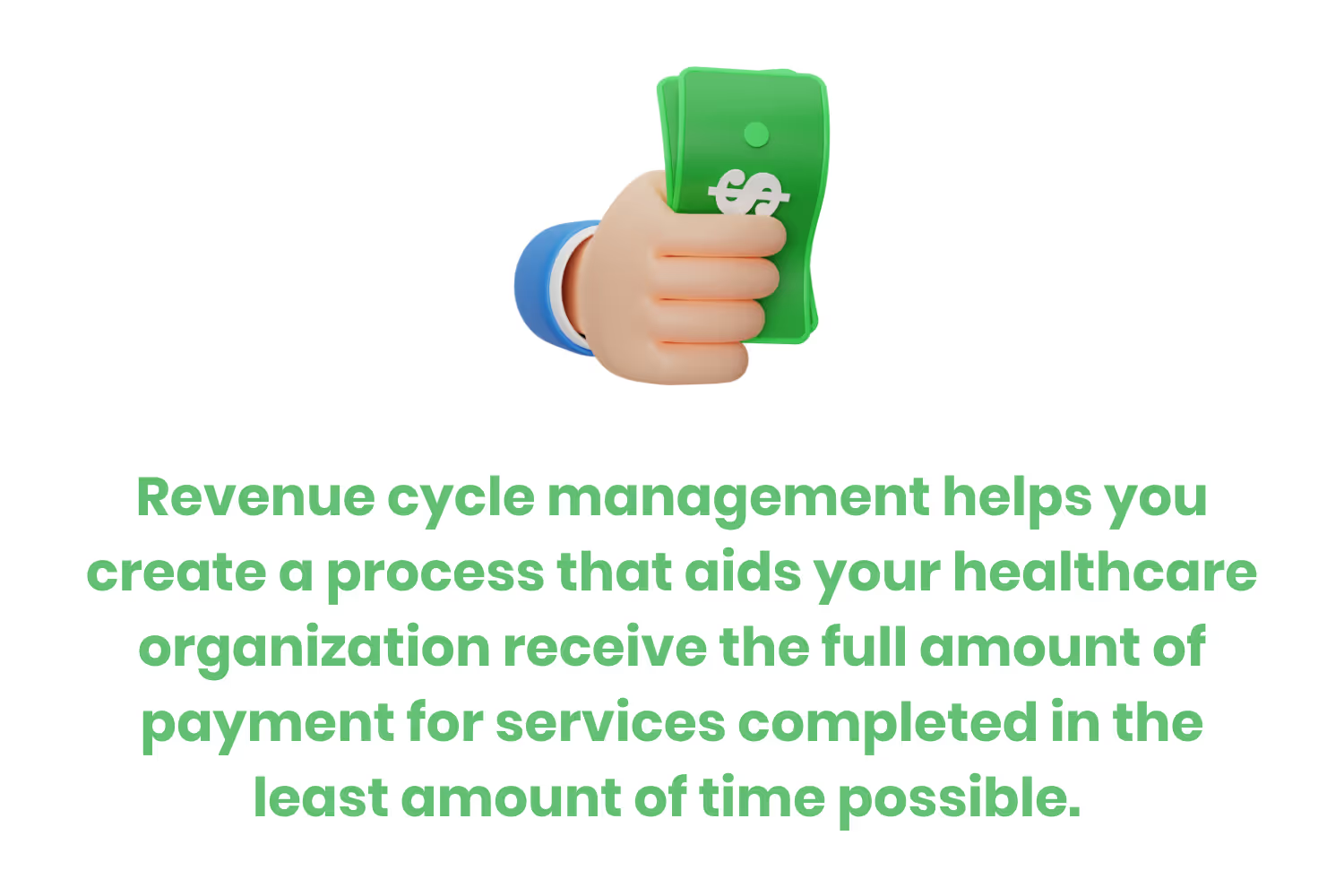Importance of Revenue Cycle Management in Healthcare: An Ultimate Guide
In this blog, we explain the importance of revenue cycle management in the healthcare space.

The revenue cycle process is what keeps hospitals, small practices, and larger healthcare systems financially healthy.
When we think of the healthcare industry, the business aspect of how these institutions run may not come to mind. In fact, it may not be something you want to think about.
Understandable of course, but acknowledging the impact that your revenue cycle has on your bottom line is essential.
It’s no surprise that healthcare organizations need money to keep the lights on. Funds need to come in to pay for necessary supplies, employees, and other accumulated costs.

Healthcare professionals spend so much time devoted to their craft and specialized areas that they simply don’t have time to ALSO worry about their finances.
The harsh reality here is that poor revenue cycle management practices cost healthcare providers 15-20% of their revenue.
So what can we do to combat this? Have no fear, revenue cycle management is here! There are things we can actively do to decrease that percentage.
In this blog, we’ll explain the importance of revenue cycle management in the healthcare space.
Defining Revenue Cycle Management
The revenue cycle goes beyond the time from when a patient seeks out a doctor for service and has an appointment. A patient engagement doesn’t end once their appointment is over or they leave the premises.
The revenue cycle officially ends once the patient and their insurance completed all of their payments toward the service received. The revenue cycle involves all of the steps involved with collecting patient revenues to keep up with expenses.
It’s used to manage both administrative and clinical functions that have to do with the hospital or practice. That means all things regarding claims, payments, and revenue are associated with the revenue cycle.

Sounds simple…right? Well, if you’ve worked in the healthcare industry then you know that this can be far from the truth.
The revenue cycle doesn’t always occur in a perfect circle. There’s a lot of back and forth happening between doctors, patients, insurance, and so on.
When you’re dealing with hundreds of patients, this can be a lot to navigate through. You might not even know where to begin. This is why it’s important to implement good practices into your revenue cycle management so that you can relieve some of these avoidable stressors or know what to do if they arise.
The Revenue Cycle Management Process
Let’s ensure that we fully understand the scope of all of the things that fall into the revenue cycle before we identify the importance of managing it.
As a reference already, this process all starts with the potential or recurring client. They’re looking to receive some type of care or service from your practice.
That patient’s going to reach out to administrative services to schedule an appointment. This could be in-person or virtually.
Before their appointment, everyone’s favorite part has to take place…paperwork! This includes your typical check-in information such as providing your name, date of birth, what you are seeking help for, and other formalities.
This is also when you will provide your insurance card to confirm co-pays or any other types of coverage you may have.

Once the appointment occurs, there are still several steps that need to occur in order to receive payment.
Accurate and sufficient claims need to be created, processed, and submitted to the patient’s insurance company.
Within this claim there are a couple of different important codes that are an important aspect of the revenue cycle process; ICD-10 and CPT codes.
ICD-10 code is short for the International Classification of Diseases. The 10 signifies the version. It’s used internationally to identify the cause and or reason that a patient is seeking medical treatment.
Meanwhile, CPT stands for Current Procedural Terminology. These codes explain the medical procedures performed/provided to patients during their appointments.
Insurance companies receive both of these codes within the claim and use them to identify how much they will cover or reimburse for the treatment.
In an ideal situation, the insurance accepts the request for payment and the healthcare provider receives their reimbursement for the services provided.
Revenue Cycle Management Hurdles
I hate to be the bearer of bad news, but situations aren’t always ideal.
Issues with submitting requests for payments, receiving claim denials, and working alongside patients who aren’t able to pay for services are all common occurrences that can happen within the revenue cycle.
If a claim denial were to occur, it would be happening at this point in the process.
As stated in a previous blog concerning handling denial claims, a denial occurs when an insurance company or other carrier denies a request for coverage on healthcare offerings or services for a patient from a professional.
In 2023, nearly 18% of insured individuals experienced a denial claim.
There are thousands of reasons that an insurance company denies your claim. Some of the most common errors that lead to denials include misspellings, miscoding and/or missing information.

In other instances, the insurance provider may simply say that they’re not going to cover the fees for the service you are requesting. This usually happens when services rendered don’t fall under the scope of things that they’ll cover or the insurance might not have a relationship with the healthcare provider.
If these denials happen, the healthcare provider receives a notification from the respective insurance company and must collect payments from the patient. This now becomes an inconvenience to the patient.
If the patient isn’t able to pay, this now results in money out of your pocket. You’ll then have to cover the charges that the insurance will not cover. This is where we see that 15% to 20% percentage of missing revenue is the result of poor revenue cycle management practices.
They say Rome wasn’t built in a day, neither are bills and submission claims.
Revenue cycle management isn’t a straightforward process. There’s a lot of back and forth between payers and providers. If a denial occurs, the insurance has to explain as to why they denied your claim. Depending on this explanation you’ll be able to fix the error and then send it back for approval. This part of the process can go on for months.
This also becomes quite a lengthy process because patients don’t always have the funds or access to resources to pay their medical bills right away.
The Importance of Revenue Cycle Management
We understand or have an idea of what a claim is and everywhere it goes during the revenue cycle process. It can sound a bit overwhelming and even stressful to handle all of this information especially when you are depending on it to keep your business up and running.
Implementing a good revenue cycle process and even working with a third-party clearinghouse helps you to thrive in the financial area of your practice.
The purpose of revenue cycle management help you create a process that aids your healthcare organization receive the full amount of payment for services completed in the least amount of time possible.
This means more revenue and time spent working in your practice rather than having to put it towards your administrative and clinical functions.

With a healthy process, you’re likely to see fewer coding errors which will result in fewer claim denials. However, when those errors do appear because it is inevitable that they will be completely erased, they are easier to point out and fix.
Your revenue cycle benefits everyone involved in the transaction. This includes you of course but your patients as well. We’re all on the same team here.
There are a lot of anxieties that come with going to the doctor already and payments or worrying about whether or not insurance covers necessary treatments, visits, or medications does not help either.
Having an efficient and effective RCM process ensures your clientele the status of claims as well as more information as to whether or not charges are being covered and why.
Everyone’s kept in the loop and the back and forth inconveniences decrease.
When finances become less of a struggle in regard to paying for healthcare services, more retention is the result.
Remember that you’re building relationships with your clientele as well as the insurance providers that you’re working alongside.
Conclusion
The revenue cycle process is the backbone of all healthcare industries both big and small. It’s what gives the healthcare industry the revenue necessary to stay up and running.
If you decide to put managing all of this on the back burner, all that changes is your access to revenue that is already yours. You just have to make sure you have all the information written and recorded to receive it.
There’s a lot of back and forth that goes along with submitting claims and receiving payments for a multitude of different reasons as we have gone over.
A healthy revenue cycle process helps to decrease the time it would take to reach your revenue as well as the time spent allocated toward administrative and clinical functions.
Ultimately this means more time for you to focus on offering value-based care to your patients than having to worry about the status of hundreds of claims at a time.
It is possible to have a well-rounded revenue cycle process and a big part of that is how you manage it.
Partnering with a Clearinghouse allows you to better analyze claims, engage with insurance carriers and patients, and leverage the technology associated with it.
Reach out to Etactics as we help you lifting that weight off your shoulders.
Emphasize your product's unique features or benefits to differentiate it from competitors
In nec dictum adipiscing pharetra enim etiam scelerisque dolor purus ipsum egestas cursus vulputate arcu egestas ut eu sed mollis consectetur mattis pharetra curabitur et maecenas in mattis fames consectetur ipsum quis risus mauris aliquam ornare nisl purus at ipsum nulla accumsan consectetur vestibulum suspendisse aliquam condimentum scelerisque lacinia pellentesque vestibulum condimentum turpis ligula pharetra dictum sapien facilisis sapien at sagittis et cursus congue.
- Pharetra curabitur et maecenas in mattis fames consectetur ipsum quis risus.
- Justo urna nisi auctor consequat consectetur dolor lectus blandit.
- Eget egestas volutpat lacinia vestibulum vitae mattis hendrerit.
- Ornare elit odio tellus orci bibendum dictum id sem congue enim amet diam.
Incorporate statistics or specific numbers to highlight the effectiveness or popularity of your offering
Convallis pellentesque ullamcorper sapien sed tristique fermentum proin amet quam tincidunt feugiat vitae neque quisque odio ut pellentesque ac mauris eget lectus. Pretium arcu turpis lacus sapien sit at eu sapien duis magna nunc nibh nam non ut nibh ultrices ultrices elementum egestas enim nisl sed cursus pellentesque sit dignissim enim euismod sit et convallis sed pelis viverra quam at nisl sit pharetra enim nisl nec vestibulum posuere in volutpat sed blandit neque risus.

Use time-sensitive language to encourage immediate action, such as "Limited Time Offer
Feugiat vitae neque quisque odio ut pellentesque ac mauris eget lectus. Pretium arcu turpis lacus sapien sit at eu sapien duis magna nunc nibh nam non ut nibh ultrices ultrices elementum egestas enim nisl sed cursus pellentesque sit dignissim enim euismod sit et convallis sed pelis viverra quam at nisl sit pharetra enim nisl nec vestibulum posuere in volutpat sed blandit neque risus.
- Pharetra curabitur et maecenas in mattis fames consectetur ipsum quis risus.
- Justo urna nisi auctor consequat consectetur dolor lectus blandit.
- Eget egestas volutpat lacinia vestibulum vitae mattis hendrerit.
- Ornare elit odio tellus orci bibendum dictum id sem congue enim amet diam.
Address customer pain points directly by showing how your product solves their problems
Feugiat vitae neque quisque odio ut pellentesque ac mauris eget lectus. Pretium arcu turpis lacus sapien sit at eu sapien duis magna nunc nibh nam non ut nibh ultrices ultrices elementum egestas enim nisl sed cursus pellentesque sit dignissim enim euismod sit et convallis sed pelis viverra quam at nisl sit pharetra enim nisl nec vestibulum posuere in volutpat sed blandit neque risus.
Vel etiam vel amet aenean eget in habitasse nunc duis tellus sem turpis risus aliquam ac volutpat tellus eu faucibus ullamcorper.
Tailor titles to your ideal customer segment using phrases like "Designed for Busy Professionals
Sed pretium id nibh id sit felis vitae volutpat volutpat adipiscing at sodales neque lectus mi phasellus commodo at elit suspendisse ornare faucibus lectus purus viverra in nec aliquet commodo et sed sed nisi tempor mi pellentesque arcu viverra pretium duis enim vulputate dignissim etiam ultrices vitae neque urna proin nibh diam turpis augue lacus.



![[ANSWERED] What is a Long-Term Care (LTC) Pharmacy](https://cdn.prod.website-files.com/67e2b8210878abcba6f91ae6/68d687806a075a1cf64659b0_WhatisLongTermCarePharmacy_925.avif)
